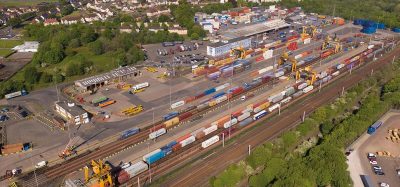The Swiss traffic transfer policy gains ground
Posted: 1 August 2013 | | No comments yet
One of the principal aims of Swiss transport policy is to transfer transalpine freight traffic from road to rail. This is why Switzerland has built the new flat-bed rail tunnels through the Alps and introduced a road charge for heavy goods vehicles. In order to further support this development, the Swiss government plans to upgrade the main rail corridor for freight traffic running from Germany via the Gotthard to Italy by 2020, enabling semi-trailers with a corner height of up to four metres to be transported along the whole route.
With the adoption of the ‘Alpine Initiative’ in 1994, Swiss voters gave the government a mandate to transfer transalpine freight traffic from road to rail. Switzerland subsequently took a range of measures to achieve this goal. These included the construction of the new rail links through the Alps and the introduction of a road charge for heavy goods vehicles. This has resulted in a reduction of approximately 600,000 HGV journeys a year through the delicate Alpine landscape. Under current legislation, Switzerland should reduce HGV traffic through the Alps from around 1.2 million journeys a year today to 650,000 journeys a year by 2018.
One of the principal aims of Swiss transport policy is to transfer transalpine freight traffic from road to rail. This is why Switzerland has built the new flat-bed rail tunnels through the Alps and introduced a road charge for heavy goods vehicles. In order to further support this development, the Swiss government plans to upgrade the main rail corridor for freight traffic running from Germany via the Gotthard to Italy by 2020, enabling semi-trailers with a corner height of up to four metres to be transported along the whole route. With the adoption of the ‘Alpine Initiative’ in 1994, Swiss voters gave the government a mandate to transfer transalpine freight traffic from road to rail. Switzerland subsequently took a range of measures to achieve this goal. These included the construction of the new rail links through the Alps and the introduction of a road charge for heavy goods vehicles. This has resulted in a reduction of approximately 600,000 HGV journeys a year through the delicate Alpine landscape. Under current legislation, Switzerland should reduce HGV traffic through the Alps from around 1.2 million journeys a year today to 650,000 journeys a year by 2018.
One of the principal aims of Swiss transport policy is to transfer transalpine freight traffic from road to rail. This is why Switzerland has built the new flat-bed rail tunnels through the Alps and introduced a road charge for heavy goods vehicles. In order to further support this development, the Swiss government plans to upgrade the main rail corridor for freight traffic running from Germany via the Gotthard to Italy by 2020, enabling semi-trailers with a corner height of up to four metres to be transported along the whole route.
With the adoption of the ‘Alpine Initiative’ in 1994, Swiss voters gave the government a mandate to transfer transalpine freight traffic from road to rail. Switzerland subsequently took a range of measures to achieve this goal. These included the construction of the new rail links through the Alps and the introduction of a road charge for heavy goods vehicles. This has resulted in a reduction of approximately 600,000 HGV journeys a year through the delicate Alpine landscape. Under current legislation, Switzerland should reduce HGV traffic through the Alps from around 1.2 million journeys a year today to 650,000 journeys a year by 2018.
However, in view of the constitutional provisions regarding the financial burden placed on road-borne freight transport and the agreements with the European Union, it will not be possible to achieve the target within this timeframe. Nevertheless, the government intends to take further measures to safeguard the success of Switzerland’s traffic transfer policy. These will comply with the agreements that Switzerland has concluded with the European Union.
The most significant new measure envisaged by the Swiss government is the upgrading of the key north-south rail corridor via the Gotthard to accommodate traffic with a corner height of four metres. This should pave the way for semitrailers with a corner height of four metres to be transported by rail along this corridor, thereby combining the advantages of road and rail transport. This segment is becoming increasingly important in freight transport and is growing strongly in comparison with other loading options. Moreover, existing capacity for fourmetre transport on the Lötschberg corridor is almost exhausted.
Given the rise in the number of four-metre semi-trailers used in transalpine transport, various companies have proposed carrying these semi-trailers on new, low-floor wagons. This option is currently being considered, but is not an alternative to constructing four-metre corridors. These wagons have not yet been fully tested and are only likely to receive approval for use in Switzerland in the second half of 2013 at the earliest. Furthermore, such a system would not create sufficient capacity. The Swiss government considers low-floor wagons to be a possible transitional or complementary solution to the four-metre corridor.
While the new Gotthard and Ceneri Base Tunnels have already been designed to accommodate corner heights of four metres, a range of corrective measures will be required along the rest of the stretch. In particular, a new tunnel tube will have to be built to replace the old 2.5km-long Bözberg Tunnel. Various smaller tunnels will also have to be upgraded and numerous platform roofs, overhead contact lines, signal equipment and overpasses will have to be adapted. While German access routes to the Gotthard corridor can already accommodate four-metre corner height traffic, adjustments on the Italian side would be needed in order to enable trains to reach Lombardy terminals. The Swiss government is requesting parliament to finance the costs of around €185 million arising in Italy because the upgrades primarily serve the interests of Swiss transport policy. The overall cost of upgrading the Gotthard corridor to accommodate four-metre corner height traffic will be around €750 million. In addition, Switzerland is also considering the possibility of contributing funding towards the construction of a new reloading terminal on the eastern side of Milan, as well as possible additional terminals. Switzerland has signed a Memor – andum of Under standing with Italy reaffirming cooperation between the two countries. The Swiss govern ment is confident that these measures will provide a substantial boost to its traffic transfer policy and that the chosen measures are not only EU compatible, but are also in the interests of the European transport sector. If parliament approves the requested funding, work should be completed by 2020.






